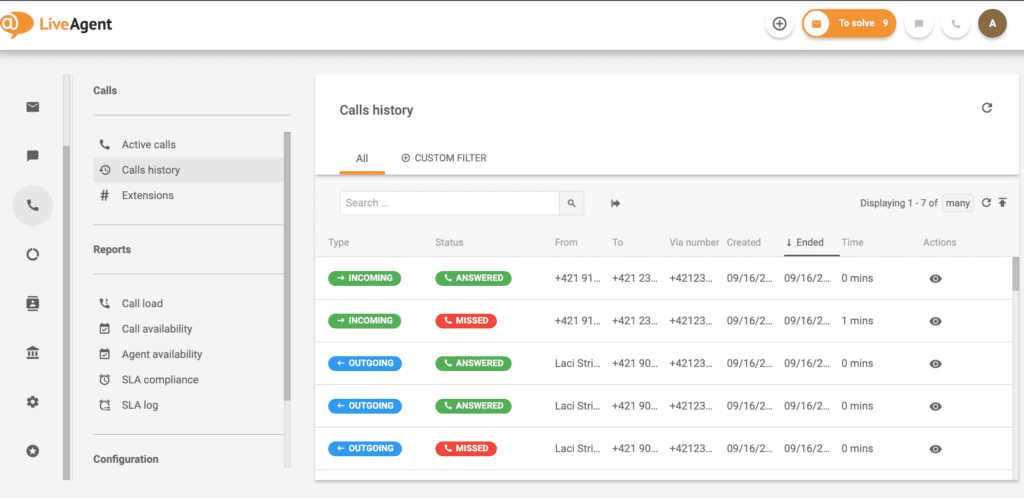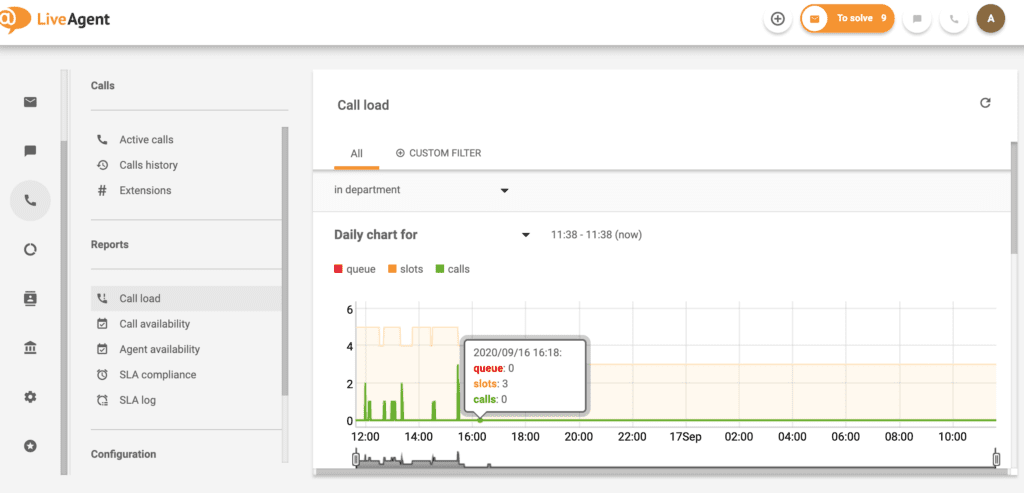Measuring and analyzing call center key performance indicators or in other words call center metrics is critical when accessing the effectiveness and efficiency of call center activities and operations. Most call center managers are aware of the need to constantly track call center KPIs. However, what is often not clear is which call metrics should be measured and what the industry standards are. The following article lists and describes the top 12 call center KPIs to track for success along with the global best practices and industry standards.

Top 12 call center industry-standard metrics
Understanding what is call center helps clarify that call center metrics may vary in standards, depending on the industry the call center belongs to. There are some global standards and best practices that businesses can use, which will help them set their team goals and measure their call performance.
If you would like to learn more, read the LiveAgent – Call center overview.


Service level
Service level (SL) measures the percentage of calls answered within a specified time frame. The traditional service level is to have 80% of calls answered in 20 seconds. That is a common goal for many call centers. Service level indicates whether a business has enough resources to connect all customers to agents and resolve their issues in a timely manner.
Average speed of answer
The average speed of answer (ASA) is defined as the average amount of time it takes call center agents to answer phone calls. This benchmark also takes into account all the calls that are not answered within 20 seconds. Thus, resulting in a global average of 28 seconds. The rate may vary depending on the time of day and the industry. If the metric is high, it makes sense to hire additional staff.
First call resolution
The first call resolution (FCR) rate is the metric that measures the percentage of calls that your agents resolve on the first interaction. Meaning, no escalation or need to follow up with the customer. Generally, the global industry benchmark for FCR is 70-75%. However, since there are different ways to measure FCR, the rate is likely to change based on the selected method.
Average handling time
Average handling time (AHT) is the average time it takes to handle a call or a transaction from start to finish. Starting from the customer’s initiation of the call, including hold time and talk time to any related tasks that may follow to resolve that call. The industry standard for AHT is around 6 minutes. Yet, this can significantly vary depending on the sector/ scale of business.
Call duration
Call duration is the average amount of time that agents spend on the phone with callers. The global call metric duration is 4 minutes per call. For inbound calls, call duration is calculated from the second the agent picks up the call to the moment the call ended. For outbound calls, it is from the moment the called party answers the phone till the call is terminated by either party.
Call wrap up time
Call wrap up time, also referred to as after call work (ACW). It is the amount of time an agent spends doing follow-up tasks to complete a customer interaction. That may include activities like adding notes into a CRM, completing forms, consulting a manager in case of unresolved questions, or anything else associated with the call. The global call center metric for call wrap up time is 6 minutes. But there is wide variability between different industries.
Average abandonment rate
Average abandonment rate (AAR) is a percentage of calls that are dropped by customers before they are able to reach an agent. This percentage shows how satisfied customers are with wait times and call experiences. The global call metric for call abandonment rate is between 5% to 8%. However, based on industry and time of day, rates can normally reach up to 20%.
Net promoter score
Net promoter score (NPS) is a customer perception index that is measured with a single question using a 0-10 scale and reported with a number from -100 to +100. While the industry standard for NPS is better than 10, which is considered ‘good,’ ‘bad,’ or ‘neutral’ can greatly vary from business to business. NPS score below zero may indicate that a company needs to work on improving customer satisfaction levels.
Customer satisfaction
The customer satisfaction (CSAT) score indicates customer’s satisfaction with a product, service, or interaction. A call center’s CSAT score is measured on a percentage scale. 100% being, complete customer satisfaction. 0% with no customer satisfaction. The global contact center statistics for customer satisfaction is 90%. However, the scores can differ widely based on the type of CSAT question asked.
Quality assurance scoring
Quality assurance (QA) measures the quality of calls in order to ensure customer satisfaction and employee productivity and is based on a set of criteria that must be covered by the agent during the call. That may include how the agent answers and ends the call, how they navigate the caller to a resolution, etc. The industry standard is random scoring of 4 calls per month, with quality score originally falling between 75 and 90%.
Adherence to schedule
The benchmark evaluates employee efficiency by measuring the percentage of time agents are clocked in compared to their scheduled hours. Call center schedule adherence can take into account the time spent on breaks or other non-call related activities. The global metric for adherence to schedule is 95%. High rates indicate that agents are cost-effective and provide responsive service. On the other hand, low rates may result in failure to meet SLAs.
Maximum occupancy
Occupancy is the percentage of time agents are actively occupied on call-related activities. This includes; talk time, hold, and wrap up time. The global industry standard for maximum occupancy is between 60-80%. A higher than 90% rate means little or no time between calls. However, this is known to negatively impact agent satisfaction and performance. This can eventually result in higher absenteeism and agent burnout.
The call center statistics have been provided by Call Centre Helper and the International Finance Commission.
Discover on your own
Knowledge is important, but only when put into practice. Test everything in our academy right inside the LiveAgent.

Try out LiveAgent for FREE
Handle all customer inquiries from one interface. Start improving your customer service with a 30-day free trial right away!
Frequently Asked Questions
What is the industry standard for call center hold time?
The industry standard for call center hold time can vary depending on the specific industry. In general, the hold time is often influenced by factors such as call volume, staffing levels, and call center efficiency. However, the goal of call centers is typically to minimize hold times, with many aiming for an average hold time under one minute.
What is a good adherence rate for a call center?
In general, adherence rate that ranges between 85-95% is considered good. It measures the extent to which call center agents adhere to their schedules (icluding their log-in and log-out times and breaks).
What affects adherence in a call center?
There are several factors that can impact adherence in a call center. These include: agent motivation, workload and schedule flexibility, mnagement and supervision, employee engagement, or training. In conclusion, adherence in a call center can be influenced By effectively managing all these factors, call centers can improve the adherence rate and consistency.
What is ASA in call center metrics?
ASA (Average Speed of Answer) is a key performance indicator that measures the average time it takes for a call to be answered by a customer service representative. This metric is important for assessing the efficiency and effectiveness of a call center in handling incoming calls. Lower ASA indicates that calls are being answered quickly, potentially leading to higher customer satisfaction and better overall performance.
What is the industry standard for the average handling time?
The industry standard for AHT is around 6 minutes. Yet, this can significantly vary depending on the sector/ scale of business.
What is the average abandonment rate?
The average abandonment rate (AAR) is a percentage of calls that are dropped by customers before they are able to reach an agent.
What are KPIs in a call center?
KPIs are Key Performing indicators that measure how well is the team/company performing in certain areas.
What is the industry benchmark for call centers?
The industry benchmark for call centers can vary depending on the specific metrics being measured and the industry in which the call center operates. Common benchmarks include average call resolution time, first call resolution rate, customer satisfaction scores, and employee turnover rates. For example, in the telecommunications industry, the benchmark for first call resolution rate might be around 70-75%, while in the healthcare industry, the benchmark for customer satisfaction scores might be around 90%. It's important to consider the specific industry and context when determining the industry benchmark for call centers.
What is a 70/30 service level?
A 70/30 service level in a Service Level Agreement (SLA) signifies the expected performance and reliability of a service. It implies that the service should be available 70% of the time, with an accepted downtime of 30%, per SLA terms. This ratio sets the expected performance standard for both the service provider and customer.
What are call center standards?
Call center standards are guidelines ensuring operational efficiency, effective customer service, and a unified customer experience. They cover communication, response times, problem-solving, and customer satisfaction metrics such as answering calls within specific rings and adhering to scripted greetings. These standards are crucial for creating a positive customer experience and maintaining operational effectiveness.
Provide excellent customer service
Discover unparalleled customer support with LiveAgent's all-in-one software. Benefit from 24/7 service, a free trial without a credit card, and seamless integration across 130+ ticketing features. Enhance your business with fast setup, AI assistance, live chat, and more. Choose LiveAgent for exceptional service and satisfied customers.
Customer communication management software
LiveAgent customer communication management software will provide personalized, quick, and knowledgeable service to your customers. Try it for free.

 Български
Български  Čeština
Čeština  Dansk
Dansk  Deutsch
Deutsch  Eesti
Eesti  Español
Español  Français
Français  Ελληνικα
Ελληνικα  Hrvatski
Hrvatski  Italiano
Italiano  Latviešu
Latviešu  Lietuviškai
Lietuviškai  Magyar
Magyar  Nederlands
Nederlands  Norsk bokmål
Norsk bokmål  Polski
Polski  Română
Română  Русский
Русский  Slovenčina
Slovenčina  Slovenščina
Slovenščina  简体中文
简体中文  Tagalog
Tagalog  Tiếng Việt
Tiếng Việt  العربية
العربية  Português
Português 




